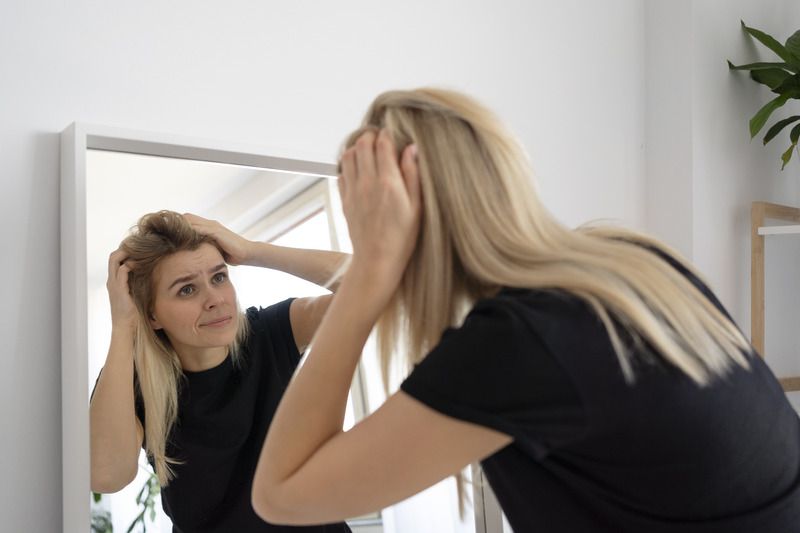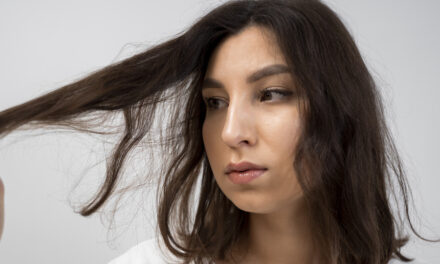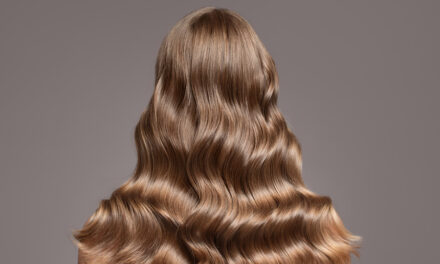
Navigating the world of natural hair care can be a journey filled with discovery and learning. When managing hair porosity, the challenge often lies in finding the right balance between nourishment and care.
This comprehensive guide aims to demystify the process, offering practical, natural methods tailored explicitly for low-porosity hair, ensuring your locks remain healthy and vibrant.
What’s the difference between High-Porosity Hair and Low-Porosity Hair?
The critical distinction between high-porosity hair, medium-porosity hair, and low-porosity hair lies in their respective cuticle structures and moisture interactions. High porosity hair is characterized by a cuticle layer with gaps, facilitating quick moisture absorption but making it prone to rapid moisture loss.
Medium porosity hair features a balanced cuticle structure for effective moisture management. Conversely, low porosity hair has a tightly packed and flat cuticle layer, resisting moisture penetration but offering better moisture retention once adequately moisturized.
Understanding this fundamental difference helps individuals tailor their hair care routines with high-porosity hair benefits from moisture-locking products. In contrast, medium-porosity hair requires techniques and products to maintain its moisture balance, and low-porosity hair requires strategies to enhance moisture absorption and avoid product build-up.
Definition and Characteristics of Low-Porosity Hair
Low-porosity hair is characterized by a unique cuticle structure where the cuticle layer lies flat, making it challenging for moisture to penetrate. This hair type often exhibits a glossy appearance when healthy, displays resistance to water saturation and typically takes longer to dry than other hair types.
Understanding these distinctive traits is essential for tailoring effective care routines that can help maintain the health and vitality of low-porosity hair.
Understanding the Challenges in Managing Low-Porosity Hair

Managing low-porosity hair can present significant challenges due to its natural resistance to moisture and certain hair products, which can lead to the accumulation of product build-up. This build-up can result in low-porosity hair feeling heavy and appearing dull, underscoring the importance of carefully selecting the right products and techniques for maintaining this hair type’s overall health and luster.
Adopting a thoughtful and tailored approach is essential to overcome these challenges to ensure that low-porosity hair remains vibrant, manageable, and free from product build-up.
Importance of Natural Methods for Low-Porosity Hair Care
Recognizing the importance of natural hair care methods for low-porosity hair is crucial, as these approaches provide gentle nurturing without harsh chemicals. Natural methods are renowned for striking the perfect balance between hydration and nourishment, effectively promoting the overall health and growth of low-porosity hair.
Embracing natural hair care practices allows individuals to address the unique needs of low-porosity hair, helping it thrive gently and sustainably, free from the potential harm associated with chemical-based products.
How to Wash Low-Porosity Hair
Follow these steps to wash low-porosity hair properly:
1. Pre-Wash Care for Low-Porosity Hair
Pre-poo treatments play a pivotal role in the care of low-porosity hair by facilitating the detangling process and preserving moisture levels when shampooing. By creating a shielding barrier, they effectively lock in the essential hydration required to maintain the health and vibrancy of the hair, especially in situations where the hair cuticles are less porous.
Even applying pre-poo treatments is critical, allowing them to sit for at least 30 minutes for maximum effect. Using a shower cap during this process helps to trap heat, improving the treatment’s efficacy.
2. Choosing the Right Natural Cleansers
When choosing natural shampoos for low-porosity hair, prioritize ingredients like aloe vera, shea butter, and glycerin. These elements cleanse gently, preserving the hair’s natural oils.
This ensures that low-porosity hair remains hydrated and healthy while being effectively cleansed.
Tips for Gentle Cleansing Without Stripping Natural Oils
- Use lukewarm water for washing low-porosity hair.
- Massage the scalp gently during the cleansing process.
- Avoid aggressive scrubbing to prevent potential damage to hair cuticles and minimize moisture loss.
- Opt for sulfate-free shampoos designed for low-porosity hair to avoid stripping natural oils.
- Consider diluting your shampoo with water for a milder cleansing experience.
- Limit the frequency of washing to only when necessary to maintain the hair’s natural oils and moisture balance.
Practical Techniques for Washing Low-Porosity Hair
Step-by-Step Guide to Washing Low-Porosity Hair
- Wet hair Thoroughly: Start by completely saturating your low-porosity hair with lukewarm water. This step is crucial as it helps lift the tightly bound cuticles slightly, facilitating better shampoo absorption.
- Apply Natural Shampoo: Choose a natural shampoo for low-porosity hair and apply it to your scalp. It’s essential to start at the scalp, where most oil and product build-up occurs. Use an amount appropriate for your hair length and thickness.
- Gentle Massage: With the shampoo on your scalp, use your fingertips to massage it gently. This motion should be smooth and downward, aligning with the direction of the hair cuticles. Gentle massaging not only cleanses the scalp but also promotes blood circulation, which is beneficial for hair health.” Insert keywords and bold them like hair shaft, absorb moisture
- Rinse Thoroughly: After massaging the shampoo through your hair, rinse it thoroughly with lukewarm water. Ensure all shampoo is removed, as any residue can lead to build-up, which is particularly problematic for low-porosity hair. Rinsing ensures your hair remains clean and free from unwanted residue.
- Applying a steaming cap or wrapping your hair strand in a warm towel post-conditioning helps open up your hair cuticle, promoting enhanced moisture absorption. This technique is particularly effective for low-porosity hair, allowing deeper penetration of conditioning products.
- Washing low-porosity hair with warm water aids in gently opening your hair cuticles, facilitating better cleansing and conditioning. Concluding your wash with a cool rinse is essential to close your hair cuticles back, helping to lock in the moisture and maintain hair health.
3. Natural Conditioning and Detangling
Natural conditioners, particularly those containing ingredients like banana and avocado, offer a lightweight yet deeply nourishing solution for low-porosity hair. These natural components are rich in essential nutrients, providing adequate hydration and promoting overall hair health without leaving a heavy residue.
Incorporating such conditioners into your hair care routine can help maintain the balance and vitality of low-porosity hair.
Tips for Effective Detangling Without Damage
- Use a wide-tooth comb for gentle detangling of low-porosity hair.
- Begin detangling at the ends of the hair and work your way up to the roots to minimize breakage.
- Apply a detangling spray or conditioner to make the process smoother and reduce friction.
- Divide your hair into manageable sections, detangling one section at a time to avoid overwhelming your hair.
- Patience is key; take time when detangling, especially if your hair is prone to tangling, to prevent unnecessary damage and breakage.
- This approach helps preserve the hair’s integrity while effectively removing tangles.
4. Post-Wash Care for Low-Porosity Hair
Utilizing lightweight leave-in conditioners or natural aloe vera gel is highly advantageous for porous hair, and moisture retention is essential, delivering essential moisture, enhancing natural shine, and maintaining optimal hydration levels without causing heaviness, effectively addressing the unique needs of low-porosity hair. For low-porosity hair, air drying is the recommended method to preserve moisture retention, while if using a hair dryer, selecting a low heat setting and continuous movement is advisable to prevent heat damage and moisture loss, emphasizing the importance of proper drying techniques to safeguard moisture content, maintain hair integrity, and reduce the risk of damage associated with high heat settings.
Styling Tips for Low-Porosity Hair
- Avoid heavy styling products to prevent build-up.
- Opt for lightweight oils like argan oil for a smooth finish.
- These oils maintain natural volume and movement in low-porosity hair.
- Use a wide-tooth comb or your fingers for gentle detangling before styling.
- Consider incorporating protective hairstyles to minimize daily manipulation.
- Experiment with heat styling tools on low heat settings to avoid excessive damage.
Common Mistakes to Avoid

- Overwashing can strip natural oils, leading to dryness.
- Wash your hair only as often as necessary to avoid overwashing.
- Avoid harmful ingredients and practices like harsh sulfates, silicones, and parabens.
- Also, steer clear of excessive heat styling to protect your low-porosity hair.
- Balance the needs of low-porosity hair by providing moisture and occasional protein treatments to maintain hair strength.
Bottom Line
Taking proper care of low-porosity hair entails a holistic approach encompassing gentle cleansing techniques, regular deep conditioning, and a commitment to avoiding harsh chemicals and products. By embracing these practices consistently, individuals with low-porosity hair can significantly improve the health and vibrancy of their locks.
It’s essential to recognize that even small, consistent efforts in hair care can yield remarkable results in maintaining the beauty and integrity of low-porosity hair. Don’t forget to explore Vitamins Revive for more insights and tips on natural hair care.
Share your experiences and join the conversation about nurturing low-porosity hair naturally!
FAQs
How should I wash my low-porosity hair?
To wash low-porosity hair effectively, use lukewarm water to open the hair cuticles, apply a sulfate-free shampoo, and use a deep conditioner to help moisturize and nourish your locks.
How do you treat low-porosity hair naturally?
Natural treatments for low-porosity hair include:
- Use warm oil treatments with oils like coconut or olive oil.
- Incorporating aloe vera gel.
- Use a steamer or warm towel to help open the hair cuticles for better product absorption.
What should low-porosity hair avoid?
Low-porosity hair should avoid heavy products, excessive heat styling, harsh sulfates, silicones, and parabens to prevent product build-up and dryness while maintaining hair health.









